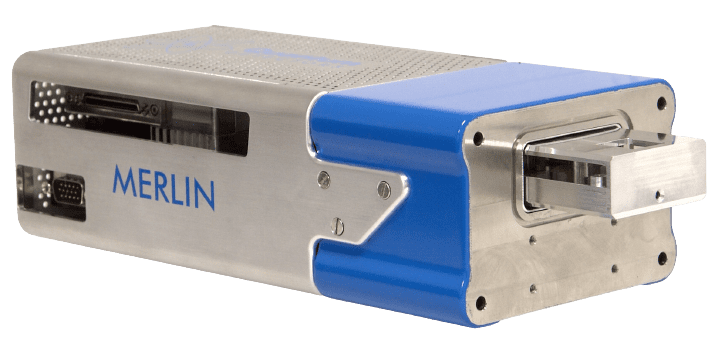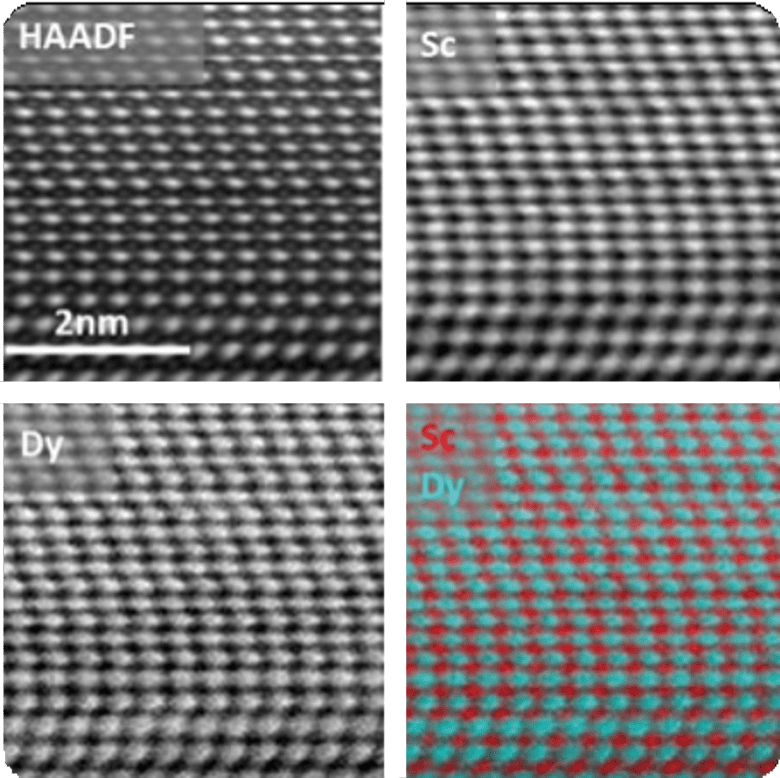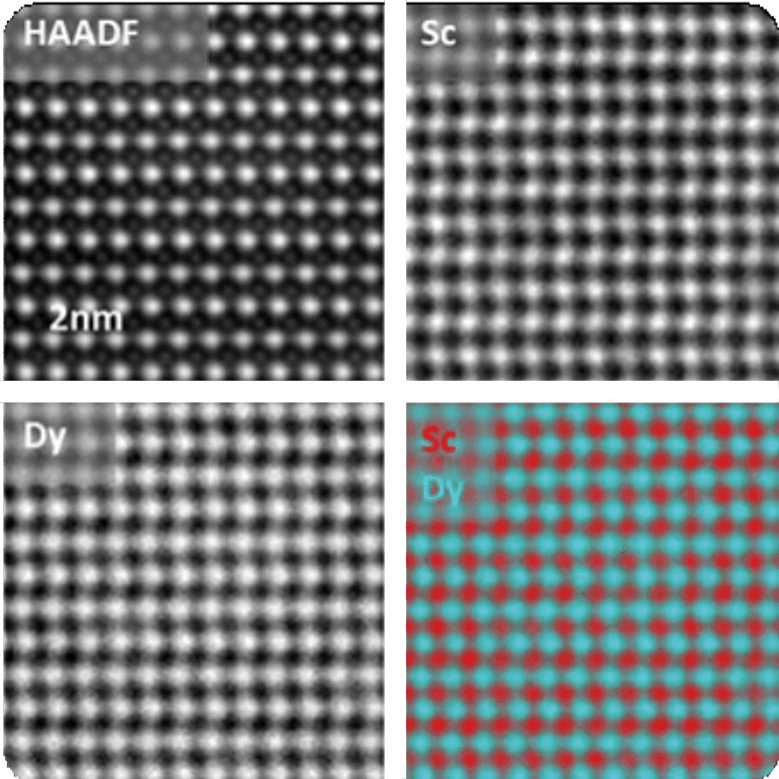
MerlinEM is a fast pixelated detector for electron microscopes. MerlinEM’s versatile technology allows for acquisition speeds greater than 21,000 frames per second (@ 1 bit mode) and comes with a workstation computer. MerlinEM is a particle counting detector – each pixel has complex analog and digital circuitry to discriminate single particle events. Noise free, zero dead time readout is possible due to the hybrid design of the detector.
MerlinEM uses threshold discriminators to separate incident electrons from a background signal. It is ideally suited for 4D STEM and dynamical TEM imaging. The detector can be triggered by external events – enabling pump-probe and in situ type of experiments. Near ideal detector performance (in terms of DQE and MTF) can be reached for electron energy decreasing towards 60 keV1.
Key applications
- 4D STEM.
- Time resolved TEM.
- Psychography.
- Strain imaging.
- Lorentz microscopy.
- Electron diffraction imaging.
- CBED.
Key features
- Direct detection: Noise-free readout of single electron events.
- Dynamic range: 24-bit maximum counting depth (1:16.7 million intensity range in a single image), 12-bit counting depth with no dead time.
- Rapid and versatile readout: Several bit depth modes allow for varying readouts speeds, including up to 1825 Hz in typical 12-bit mode, and up to 21,000 Hz in binary mode (1-bit). Additionally, the shutter speed can be opened for as low as 200 ns for pump-probe experiments.
- Wide energy range and radiation tolerance:30 keV – 300 keV operating range suitable for low and high energy experiments.
- Size and Mount: 256 x 256 pixels with retractable and static mounts fits most microscopes.
The Quantum Detectors Scan Engine allows advanced, highly customisable STEM scanning on electron microscopes.
Key benefits
- Generate random arbitrary scans using a table of positions as large as 50 Mpixels to minimise beam damage to delicate samples.
- Generate conventional raster scans for STEM imaging or EELS hyperspectral imaging.
- Acquire up to 6 video channels simultaneously, with the option of 2 of them being used as external scan inputs.
- Acquire up to 6 event sources as data channels.
- Synchronise scan with multiple cameras.
- Generate a variety of signals to control lasers for pump-probe experiments, detectors etc.
- Minimum dwell time per pixel: 200 ns.
- Python / C++ API.


Figure 1: HAADF image and elemental maps of Sc and Dy in ScDyO3 without drift correction.

Figure 2: HAADF image and elemental maps of Sc and Dy in ScDyO3 with real-time drift correction. Note that the Dy-Dy zig-zag chains (shift amplitude 70 pm) due to the structural distortion of DyScO3 are clearly visible in both the HAADF and the Dy maps.
Here we report on work by Marcel Tencé et al. on real-time EELS hyperspectral imaging, using the Quantum Detectors Scan Engine in conjunction with the MerlinEELS direct electron detector, taking advantage of high-speed acquisition and noiseless readout. This detector enables hyperspectral images to be recorded in sequence while adjusting the scanned area between each spectrum to remain on the same area of the sample. To achieve this, the group used cross-correlations between successive HAADF images acquired simultaneously with the EELS hyperspectral images to estimate the drift occurring during each scan.
This approach eliminates the need for a separately defined drift-calculation image as is commonly used at present, but which often presents difficulties since a suitable region is not always available.
Figure 1 shows an HAADF image and elemental maps of the Sc L edge (ca. 400 eV) and Dy M edge (ca. 1300 eV) signals from a conventional hyperspectral acquisition without drift correction on an ScDyO3 crystal, oriented along the [100] pseudo-cubic axis. The dwell time was 20 ms, giving a total acquisition time of 444 s. Considerable drift occurred, producing distortions in the images.
Figure 2 shows the equivalent results using their approach with the Quantum Detectors Scan Engine. Here, 100 hyperspectral acquisitions, each with a nominal pixel dwell time of 200 μs, were collected from the same area and summed. The total signal acquisition time is thus the same as in Figure 1 and the count levels were similar. However, the resulting image and maps are essentially free of drift distortion. This method is the way forward for EELS hyperspectral imaging.
Technical specifications
| Scanengine outputs: | 2 Programmable outputs, range ±10 V |
| Arbitrary scan mode: | Enables Arbitrary Sparse Imaging reducing beam damage to samples |
| Minimum dwell time per pixel: | 200 ns |
| Video inputs: | 6 |
| Synchronisation outputs: | 8 TTL |
| Digital input lines: | 5 TTL |
| Beam blanking control: | TTL |
| Flyback time: | µs à ms |
| Communication : | USB 3.0 |
| Operating system: | Windows 10 |
| Dimensions : | 483mm x 215mm x 88mm |
Technical specifications
| Sensor : | Silicon 500 µm |
| Sensor type : | Reverse-biased silicon hybrid diode array |
| Pixel size : | 55 x 55 µm |
| Active zone : | 14 mm x 14 mm or 28 mm x 28 mm |
| Pixels : | 256 x 256 (single) or 512 x 512 (quadruple) |
| Playback noise : | Zero with defined thresholds |
| DQE at 60keV : | 1 at zero frequency 0.45 at Nyquist1 |
| MTF at 60 keV : | >0.62 to Nyquist (mode-dependent) |
| Max. frame rate (continuous) : | 1825 Hz (12-bit) |
| Gap time (continuous) : | 0 µs |
| Maximum dynamic range : | 24 bits - up to 16,777,216 strokes per pixel |
| Trigger voltage : | Impulse 3.3 / 5 V TTL or via integrated software |
| Communication : | Up to 10m VHDCI cable; TCP/IP protocol |
| Energy range : | 30 keV - 300 keV |
| Software : | Labview and TCP/IP protocol |
| Montage : | Static or retractable at the bottom of the column or on a 35 mm port |
Quantum Detectors present 4D STEM with MerlinEM
Quantum Detectors live demonstration of the MerlinEM direct electron detector
